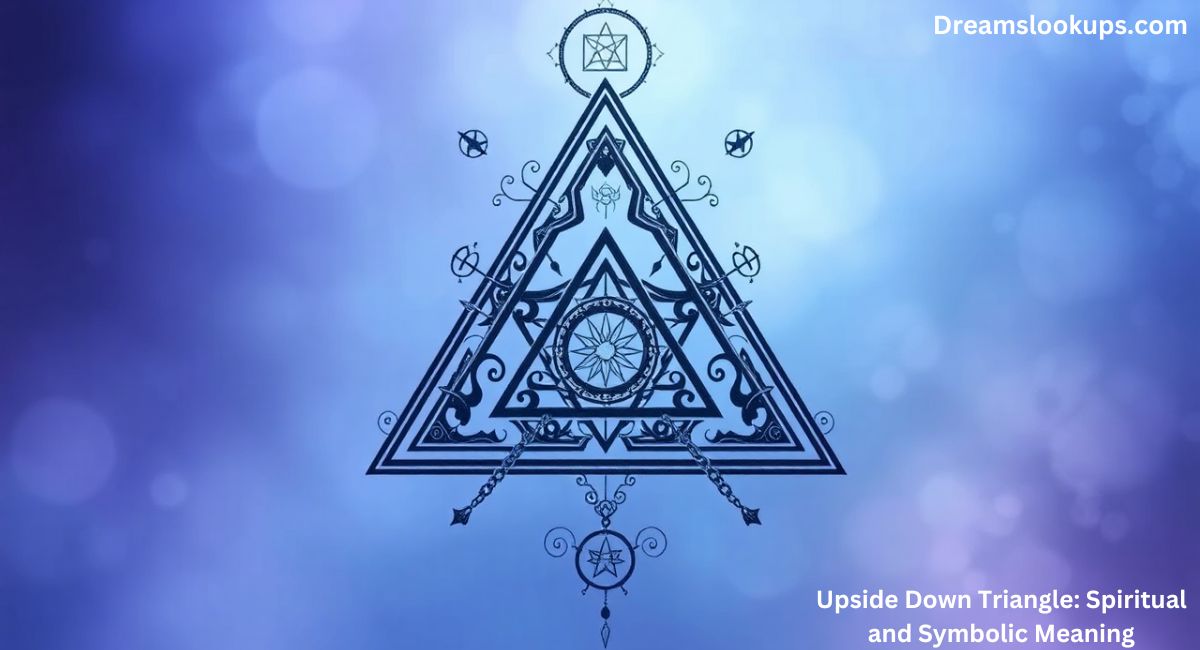Upside-down triangle is a powerful symbol that holds spiritual and symbolic meanings. This symbol has deep roots in ancient civilizations, representing the Divine Feminine, transformation, and receptivity.
It’s a symbol that continues to carry significance in modern-day cultures and movements. Its spiritual meaning is closely linked to the water element and feminine energy.
It signifying qualities like intuition, nurturing, and creativity. The upside-down triangle is often used to represent empowerment, particularly in feminist and LGBTQ+ movements, symbolizing strength and resilience in the face of oppression.
Symbolism of the Upside Down Triangle
The upside down triangle symbol carries powerful symbolic meanings that resonate on multiple levels. At its core, it represents the Divine Feminine principle, which is often associated with receptivity, nurturing, and creation.
This symbol is often linked to the water element, symbolizing fluidity, intuition, and emotional depth. Just as a chalice holds water, the upside-down triangle is seen as a vessel that receives and nurtures energy, both spiritually and physically.
Upside Down Triangle Meaning
When we consider the upside down triangle symbol meaning, it’s clear that this shape represents more than just geometry. It’s about balance, where the broad base points downwards, symbolizing a grounding force.
This is often seen as a symbol of stability, yet paradoxically, it can also signify instability a tension between opposites. It’s no surprise that the symbol finds meaning in both spiritual practices and modern movements.
- Feminine Energy: The triangle’s downward orientation aligns with feminine energy, which is inherently receptive and creative. It embodies qualities such as intuition, nurturing, and sensitivity.
- Spiritual Receptivity: The symbol is a reminder of the need to receive—whether it’s divine wisdom, love, or knowledge. It reflects a sense of openness to the flow of life and experiences.
- Transformation and Purification: Alchemically, the upside-down triangle is linked to transformation and purification, especially within the process of spiritual alchemy.
Spiritual Meaning of the Upside Down Triangle
In spiritual contexts, the upside-down triangle often connects to concepts of unity and trinity, but with a twist—reversing traditional perspectives. The upside-down triangle is thought to embody inverted forms of the divine.
The Water Element and Feminine Energy
The water element symbolism is integral to the spiritual meaning of the upside-down triangle. Water is often seen as the feminine energy itself fluid, deep, and ever-changing. As water nourishes life, the upside-down triangle acts as a metaphor for the chalice, a vessel that holds spiritual or emotional energy.
This connection to the chalice further reinforces the triangle’s role in representing feminine qualities and the act of receiving.
- Chalice: In many traditions, a chalice represents the womb, the sacred container for life. Similarly, the upside-down triangle can represent the womb a place of growth, creativity, and transformation.
The Divine Feminine Principle
The upside-down triangle also reflects the Divine Feminine Principle, which is central to many spiritual practices. It symbolizes a rejection of masculine dominance, favoring instead the feminine virtues of intuition, emotion, and creativity.
In both alchemy and spirituality, this principle is often associated with deities such as Shakti in Hinduism, Devi, and even Pahana in Buddhism.
Historical Significance of the Upside Down Triangle
Ancient Civilizations
The upside down triangle has held spiritual significance for thousands of years. Ancient civilizations, such as the Egyptians, Greeks, and Romans, incorporated triangles into their religious and architectural designs.
- Ancient Egypt: The triangle was a symbol of the pyramid, which represented a connection to the divine and the afterlife. The upside-down triangle’s shape can be seen as a metaphor for spiritual receptivity and transformation.
- Ancient Greece and Rome: The Greeks and Romans often associated the triangle with the elements, as well as with divine power. Its inverted form represented the feminine aspect of life and the divine.
World War II and Nazi Classification
During World War II, the Nazi classification system used the inverted triangle as a way of marking and dehumanizing prisoners in concentration camps.
Prisoners were forced to wear badges that displayed colored triangles pointing downwards, each color representing a specific group.
- Nazi Classification: The inverted triangle became a painful symbol of oppression, marking Jews, LGBTQ+ individuals, Romani people, and others targeted by the regime.
Religious Contexts
Christianity: Unity and the Holy Trinity
In Christianity, the upside down triangle can symbolize the inversion of the Holy Trinity—the Father, the Son, and the Holy Spirit.
The symbol of the triangle represents the divine unity, and the inverted form reflects the humility and reversal of power.
- Unity in Christianity: The triangle, when turned upside down, can be seen as a spiritual reversal, symbolizing humility and the power of the Holy Trinity. It speaks to the idea of divine sacrifice and submission to a higher purpose.
Hinduism: Shakti and Devi
In Hinduism, the upside down triangle is strongly associated with Shakti, the divine feminine energy. The triangle represents the creative energy that flows from the goddess Devi, symbolizing fertility, power, and transformation.
- Shakti in Hinduism: The inverted triangle reflects Shakti’s power to create, destroy, and transform, embodying the feminine principle in the universe.
Buddhism: Spiritual Awakening and Pahana
In Buddhism, the triangle is often connected to the idea of awakening and spiritual transformation. The inverted triangle in Buddhist symbolism might suggest a reversal of ego and a focus on the path to enlightenment.
- Pahana: The idea of spiritual purification and transformation can also be reflected in the upside down triangle, as it connects to the journey of shedding illusions and achieving spiritual clarity.
Alchemical Meanings
In alchemy, the upside-down triangle is used to represent the element of water. Water in alchemy is linked to purification and healing.
Water Element Symbolism
The element of water is central in alchemical practices, where it’s considered a force of transformation and healing.
The upside-down triangle association with water enhances its symbolic role in purification, both physically and spiritually.
- Alchemical Context: In the process of alchemy, the upside-down triangle represents spiritual purification, as water transforms and cleanses all that it touches.
Cultural Contexts and Associations
The upside down triangle has had a profound impact on many cultural movements, especially in modern times.
Feminist Movements
The upside down triangle has been reclaimed by feminist movements to represent female empowerment and resistance. This symbol has been used in protests and as a visual tool to challenge patriarchal structures.
- Feminist Empowerment: The inverted triangle speaks to resilience, empowerment, and the strength of women in the face of adversity.
LGBTQ+ Symbolism
In the LGBTQ+ community, the upside down triangle has been reclaimed as a symbol of pride and resilience. It represents both a historical marker of oppression and a modern symbol of freedom and identity.
- LGBTQ+ Pride: The triangle historical use during the Nazi era is now inverted to signify pride, identity, and resistance against oppression.
Political Movements and Resistance
The upside down triangle has been used by grassroots movements as a symbol of anti-fascism, anti-racism, and resistance against tyranny. It embodies the struggle for social justice and equality.
Contemporary Uses
Today, the upside down triangle continues to be a powerful symbol across different domains, such as traffic signs, tattoo designs, and political movements.
Traffic Signs: Yield
The yield sign in traffic signals often features an inverted triangle, symbolizing the need to yield or give way. This interpretation reinforces the receptivity and openness suggested by the upside down triangle symbol.
Tattoo Designs
The upside down triangle tattoo has become a popular design representing personal transformation and strength. It embodies empowerment and is often seen in the context of spiritual growth.
- Tattoo Symbolism: People choose this design to represent their journey of change, inner power, and connection to feminine energy.
Conclusion
The upside down triangle is a symbol that encompasses profound meanings across various cultures, spiritual practices, and historical contexts. It represents feminine energy, spiritual transformation, and resilience in the face of adversity.
The symbol’s connection to the water element emphasizes qualities like receptivity, intuition, and nurturing, while its historical use during oppressive regimes has been reclaimed by modern movements such as LGBTQ+ pride and feminist activism.
Whether seen as a representation of the divine feminine, spiritual awakening, or political resistance, the upside-down triangle continues to carry significant meaning today. Its versatility makes it a powerful symbol of empowerment, transformation, and the ongoing fight for equality and justice across the world.

Sara Barton is the insightful voice behind Spiritual Symbols, dedicated to exploring the deeper meanings of birds, places, and everyday objects. With a passion for spirituality and a keen understanding of symbolism, Sara shares her knowledge to help readers discover the spiritual messages that surround them. Her thoughtful approach invites everyone to connect with the world on a more profound level.

